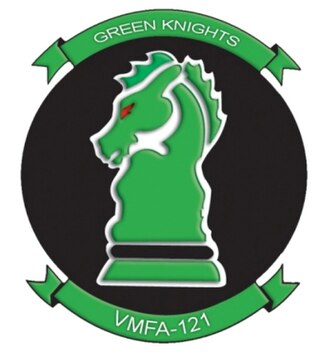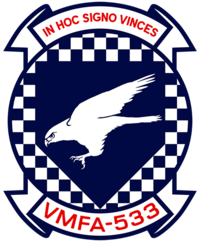
Marine Corps Air Station Beaufort or MCAS Beaufort is a United States Marine Corps (USMC) air base located 5 kilometres (3.1 mi) northwest of the central business district of Beaufort, a city in Beaufort County, South Carolina, United States. About 4,700 personnel serve at the station, and it is home to four Marine Corps F/A-18 Hornet fighter-attack squadrons and one F-35B Lighting II training squadron.

Marine Fighter Attack Squadron 212 (VMFA-212) was a United States Marine Corps F/A-18 Hornet squadron. Most recently known as the "Lancers", the squadron was last based at Marine Corps Air Station Iwakuni, Japan and fell under the command of Marine Aircraft Group 12 (MAG-12) and the 1st Marine Aircraft Wing. VMFA-212 has an extensive combat history having participated in combat operations during World War II, the Korean War, Vietnam War, the Gulf War, and Operation Enduring Freedom. Due to a re-organization within Marine aviation, the squadron was deactivated in 2008.

Marine Fighter Attack Squadron 232 (VMFA-232) is a United States Marine Corps F/A-18 Hornet squadron. Nicknamed the "Red Devils", the squadron is based at Marine Corps Air Station Miramar, California and falls under the command of Marine Aircraft Group 11 (MAG-11) and the 3rd Marine Aircraft Wing. The Red Devils are the oldest and most decorated fighter squadron in the Marine Corps.

Marine Fighter Attack Squadron 323 (VMFA-323) is an aircraft carrier-based aviation squadron of the United States Marine Corps. The squadron is equipped with the McDonnell Douglas F/A-18C Hornet and is based at Marine Corps Air Station Miramar, California, United States. It falls under the command of Marine Aircraft Group 11 (MAG-11) and the 3rd Marine Aircraft Wing but deploys with the U.S. Navy's Carrier Air Wing 17 (CVW-17). Their tail code is WS and their radio callsign is Snake.

Marine Fighter Attack Squadron 122 (VMFA-122) is a United States Marine Corps fighter attack squadron flying the F-35B Lightning II. The squadron is based out of Marine Corps Air Station Yuma, AZ and falls under the command of Marine Aircraft Group 13 (MAG-13) and the 3rd Marine Aircraft Wing. The squadron nickname is the "Flying Leathernecks," and their traditional radio call sign is "Nickel". On November 14, 2017, VMFA-122 opened a new chapter of their history, transitioning from the McDonnell Douglas F/A-18C Hornet to the Lockheed Martin F-35B Lightning II and moving from MCAS Beaufort and MAG-31, 2nd MAW to MCAS Yuma and MAG-13, 3rd MAW.

Marine Fighter Attack Squadron 333 (VMFA-333) was a United States Marine Corps fighter squadron consisting of F/A-18 Hornets. Known as the "Fighting Shamrocks" and “Trip Trey”, the squadron participated in action during World War II, the Vietnam War and Operation Desert Storm The squadron’s aircraft were easily recognizable by the row of three shamrocks painted on the vertical stabilizers of their aircraft. They were decommissioned on 31 March 1992.

Marine Fighter Attack Squadron 214 (VMFA-214) is a United States Marine Corps fighter attack squadron flying the Lockheed Martin F-35B Lighting II. The squadron's home field is Marine Corps Air Station Yuma, Arizona, and it is assigned to Marine Aircraft Group 13 (MAG-13) of the 3rd Marine Aircraft Wing.

Marine Fighter Attack Squadron 311 (VMFA-311) is a United States Marine Corps fighter attack squadron consisting of F-35C Lightning II. Known as the "Tomcats", the squadron is based at Marine Corps Air Station Miramar, California and falls under the command of Marine Aircraft Group 11 (MAG-11) and the 3rd Marine Aircraft Wing.

Marine Fighter Attack Training Squadron 502 (VMFAT-502) is a United States Marine Corps fighter attack training squadron flying the Lockheed Martin F-35 Lightning II. Known as the "Flying Nightmares", the squadron maintains the history of Marine Attack Squadron 513 (VMA-513) which dates back to World War II and was decommissioned on 12 July 2013. The squadron is based at Marine Corps Air Station Miramar and falls under the command of Marine Aircraft Group 11 and the 3rd Marine Aircraft Wing

Marine Fighter Attack Squadron 115 (VMFA-115) was a United States Marine Corps F/A-18 Hornet squadron. Officially nicknamed the "Silver Eagles" and on occasion Joe's Jokers after their first commanding officer Major Joe Foss, the squadron was last based at Marine Corps Air Station Beaufort, South Carolina and fell under the command of Marine Aircraft Group 31 (MAG-31) and the 2nd Marine Aircraft Wing. The squadron participated in combat operations during World War II, the Korean and Vietnam Wars and has deployed in support of Operation Iraqi Freedom with a final deployment in 2008 to Al Asad Airbase in western Iraq. The Squadron radio callsign was "Blade".

Marine Fighter Attack Squadron 542 (VMFA-542) is a United States Marine Corps Aviation fighter attack squadron flying the F-35B Lightning II. VMFA-542 is based at Marine Corps Air Station Cherry Point, North Carolina and falls under the command of Marine Aircraft Group 14 (MAG-14) and the 2nd Marine Aircraft Wing.

Marine Fighter Attack Squadron 225 (VMFA-225) is a United States Marine Corps fighter attack squadron flying the F-35B Lightning II. The squadron, known as the "Vikings", is based at Marine Corps Air Station Yuma in Arizona and falls under the command of Marine Aircraft Group 13 (MAG-13) and the 3rd Marine Aircraft Wing.

Marine All Weather Fighter Attack Squadron 224 is a United States Marine Corps F/A-18 Hornet squadron. Also known as the "Fighting Bengals", the squadron is based at Marine Corps Air Station Beaufort, South Carolina and falls under the command of Marine Aircraft Group 31 (MAG-31) and the 2nd Marine Aircraft Wing. The Bengals are the only Marine F/A-18D Hornet Squadron currently operating out of MCAS Beaufort.

Marine Fighter Attack Squadron 121 (VMFA-121), also known as the "Green Knights", is a United States Marine Corps aircraft squadron operating the F-35B Lightning II. The squadron is based at Marine Corps Air Station Iwakuni, Japan and falls under the command of Marine Aircraft Group 12 (MAG-12) and the 1st Marine Aircraft Wing. Their tail code is VK and their radio call sign is "Combat".

Marine Fighter Attack Squadron 312 (VMFA-312) is a United States Marine Corps F/A-18C Hornet squadron. Also known as the "Checkerboards", the squadron is based at Marine Corps Air Station Beaufort, South Carolina and falls under the command of Marine Aircraft Group 31 (MAG-31) and the 2nd Marine Aircraft Wing. The Radio Callsign is "Check."

Marine Fighter Attack Squadron 242 (VMFA-242) is a United States Marine Corps squadron flying F-35B Lightning II STOVL Stealth Fighter. The squadron, known as the "Bats", is based at Marine Corps Air Station Iwakuni, Japan and falls under the command of Marine Aircraft Group 12 (MAG-12) and the 1st Marine Aircraft Wing. The radio callsign is "Profane".

Marine Aircraft Group 15 (MAG-15) was a United States Marine Corps aviation group established during World War II. MAG-15, a transport and photo-reconnaissance training group, was commissioned on 1 March 1942, headquartered at Camp Kearny, San Diego. In addition to radio and photographic training, the Group also conducted a navigation school. Additional roles included West Coast aircraft acceptance and transport service for the Marine Corps.

VMFA(AW)-332 Marine All Weather Fighter Attack Squadron 332 was a United States Marine Corps F/A-18 Hornet squadron. Also known as the "Moonlighters", the squadron was based at Marine Corps Air Station Beaufort, South Carolina as part of Marine Aircraft Group 31 (MAG-31), 2nd Marine Aircraft Wing. The squadron flew its last flight in the F/A-18 Hornet on March 30, 2007. At the time of their deactivation, they held the longest streak of mishap-free flight hours for a tactical jet squadron at 109,000 hours.

Marine Fighter Attack Training Squadron 501 (VMFAT-501) is a training squadron in the United States Marine Corps, consisting of 27 F-35B Lightning II aircraft and serves as the Fleet Replacement Squadron. Known as the "Warlords," the squadron is based at Marine Corps Air Station Beaufort, South Carolina and falls administratively under Marine Aircraft Group 31 and the 2nd Marine Aircraft Wing. The squadron has assumed the lineage of VMFA-451 which was originally known as the “Blue Devils” and saw action during World War II and Operation Desert Storm. They were decommissioned on January 31, 1997.





























